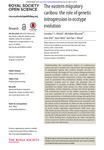Please use this identifier to cite or link to this item:
http://lib.hpu.edu.vn/handle/123456789/23538Full metadata record
| DC Field | Value | Language |
|---|---|---|
| dc.contributor.author | Klütsch, Cornelya F. C. | en_US |
| dc.contributor.author | Manseau, Micheline | en_US |
| dc.contributor.author | Trim, Vicki | en_US |
| dc.date.accessioned | 2016-10-11T05:37:09Z | |
| dc.date.available | 2016-10-11T05:37:09Z | |
| dc.date.issued | 2016 | en_US |
| dc.identifier.other | HPU4160650 | en_US |
| dc.identifier.uri | https://lib.hpu.edu.vn/handle/123456789/23538 | en_US |
| dc.description.abstract | Understanding the evolutionary history of contemporary animal groups is essential for conservation and management of endangered species like caribou (Rangifer tarandus). In central Canada, the ranges of two caribou subspecies (barren-ground/woodland caribou) and two woodland caribou ecotypes (boreal/eastern migratory) overlap. Our objectives were to reconstruct the evolutionary history of the eastern migratory ecotype and to assess the potential role of introgression in ecotype evolution. STRUCTURE analyses identified five higher order groups (i.e. three boreal caribou populations, eastern migratory ecotype and barren-ground). | en_US |
| dc.format.extent | 13 p. | en_US |
| dc.format.mimetype | application/pdf | en_US |
| dc.language.iso | en | en_US |
| dc.subject | Biology | en_US |
| dc.subject | Evolution | en_US |
| dc.subject | Genetics | en_US |
| dc.subject | Ecology | en_US |
| dc.subject | Approximate Bayesian computation | en_US |
| dc.subject | Ecotype | en_US |
| dc.subject | Secondary contact zone | en_US |
| dc.subject | Species at risk | en_US |
| dc.title | The easternmigratory caribou | en_US |
| dc.type | Article | en_US |
| dc.size | 1.05MB | en_US |
| dc.department | Education | en_US |
| Appears in Collections: | Education | |
Files in This Item:
| File | Description | Size | Format | |
|---|---|---|---|---|
| 0533_Theeasternmigratorycaribou.pdf Restricted Access | 1.09 MB | Adobe PDF |  View/Open Request a copy |
Items in DSpace are protected by copyright, with all rights reserved, unless otherwise indicated.
